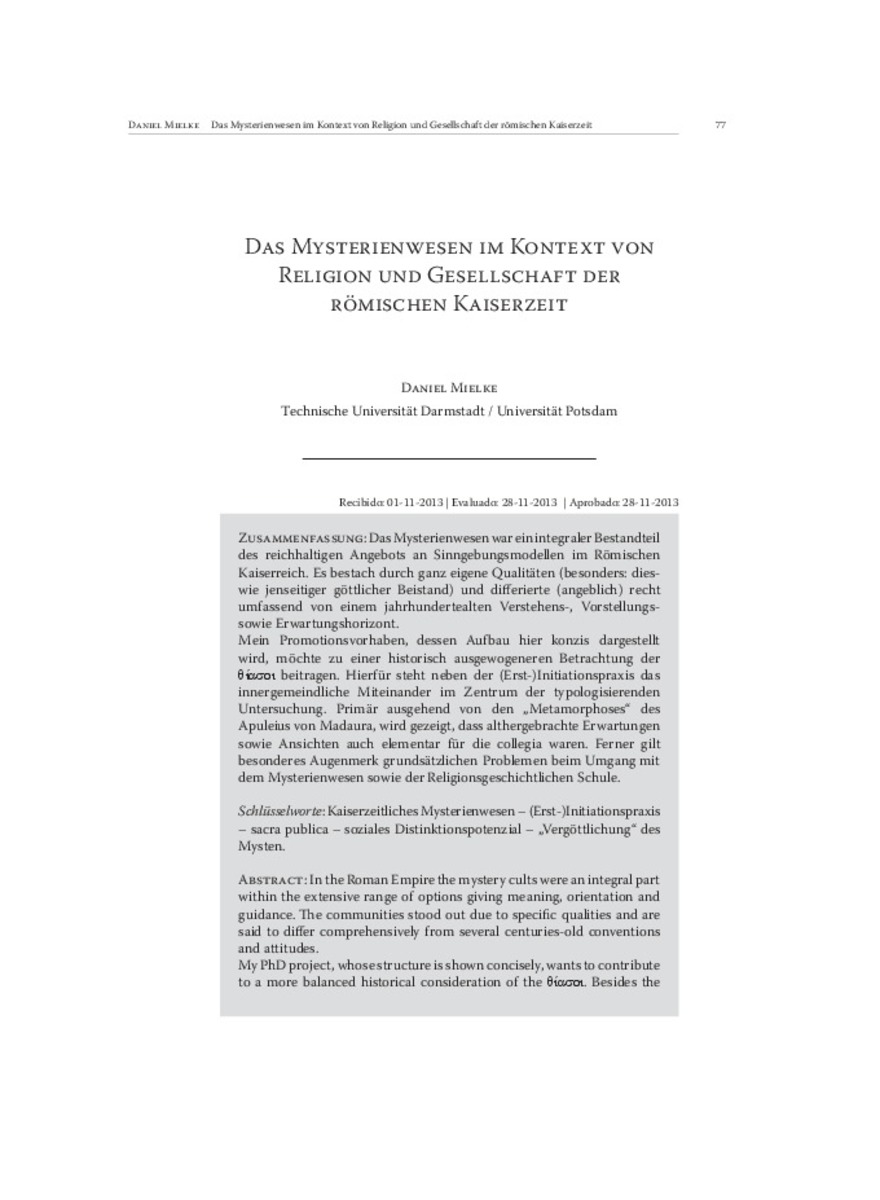Mostrar el registro sencillo del ítem
Das Mysterienwesen im Kontext von Religion und Gesellschaft der römischen Kaiserzeit.
| dc.contributor.author | Mielke, Daniel | |
| dc.date.accessioned | 2016-02-19T08:24:50Z | |
| dc.date.available | 2016-02-19T08:24:50Z | |
| dc.date.issued | 2014 | |
| dc.identifier.uri | http://hdl.handle.net/10234/150705 | |
| dc.description.abstract | Das Mysterienwesen war ein integraler Bestandteil des reichhaltigen Angebots an Sinngebungsmodellen im Römischen Kaiserreich. Es bestach durch ganz eigene Qualitäten (besonders: dieswie jenseitiger göttlicher Beistand) und diff erierte (angeblich) recht umfassend von einem jahrhundertealten Verstehens-, Vorstellungssowie Erwartungshorizont. Mein Promotionsvorhaben, dessen Aufbau hier konzis dargestellt wird, möchte zu einer historisch ausgewogeneren Betrachtung der θίασοι beitragen. Hierfür steht neben der (Erst-)Initiationspraxis das innergemeindliche Miteinander im Zentrum der typologisierenden Untersuchung. Primär ausgehend von den „Metamorphoses“ des Apuleius von Madaura, wird gezeigt, dass althergebrachte Erwartungen sowie Ansichten auch elementar für die collegia waren. Ferner gilt besonderes Augenmerk grundsätzlichen Problemen beim Umgang mit dem Mysterienwesen sowie der Religionsgeschichtlichen Schule. | ca_CA |
| dc.description.abstract | In the Roman Empire the mystery cults were an integral part within the extensive range of options giving meaning, orientation and guidance. The communities stood out due to specifi c qualities and are said to differ comprehensively from several centuries-old conventions and attitudes. My PhD project, whose structure is shown concisely, wants to contribute to a more balanced historical consideration of the θίασοι. Besides the (first) initiation practice the typological investigation centres on the circles’ togetherness. Primarily emanating from the „Metamorphoses” of Apuleius of Madaura, it is shown that certain traditional expectations as well as opinions were elementary for the collegia, too. Furthermore, special attention is drawn to the basic problems dealing with the ancient mystery cults and the Religionsgeschichtliche Schule. | ca_CA |
| dc.format.extent | 28 p. | ca_CA |
| dc.format.mimetype | application/pdf | ca_CA |
| dc.language.iso | deu | ca_CA |
| dc.relation.isPartOf | Potestas, 7 (2014) | ca_CA |
| dc.rights.uri | http://creativecommons.org/licenses/by-sa/4.0/ | * |
| dc.subject | Kaiserzeitliches Mysterienwesen | ca_CA |
| dc.subject | Initiationspraxis | ca_CA |
| dc.subject | sacra publica | ca_CA |
| dc.subject | soziales Distinktionspotenzial | ca_CA |
| dc.subject | "Vergöttlichung" des Mysten | ca_CA |
| dc.subject | Mystery cults in the Roman Empire | ca_CA |
| dc.subject | initiation practice | ca_CA |
| dc.subject | potential of social distinction | ca_CA |
| dc.subject | "deification" of the mystes | ca_CA |
| dc.title | Das Mysterienwesen im Kontext von Religion und Gesellschaft der römischen Kaiserzeit. | ca_CA |
| dc.type | info:eu-repo/semantics/article | ca_CA |
| dc.identifier.doi | http://dx.doi.org/10.6035/Potestas.2014.7.4 | |
| dc.rights.accessRights | info:eu-repo/semantics/openAccess | ca_CA |
| dc.relation.publisherVersion | http://www.e-revistes.uji.es/index.php/potestas/article/view/1693/1476 | ca_CA |
Ficheros en el ítem
Este ítem aparece en la(s) siguiente(s) colección(ones)
-
Potestas_2014_ no.7 [10]








